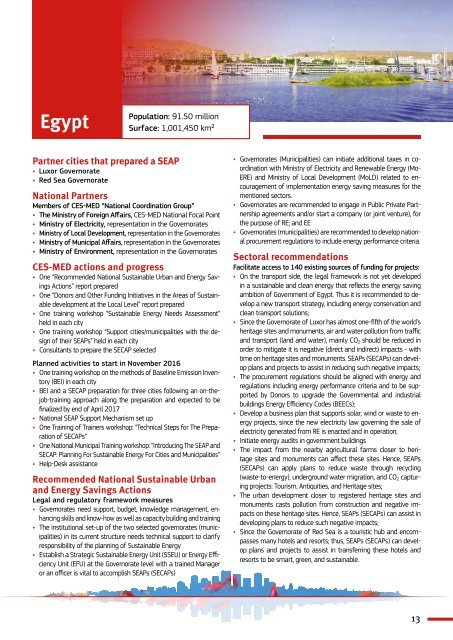CES-MED Milestones EN_WEB_rev July 2017
Create successful ePaper yourself
Turn your PDF publications into a flip-book with our unique Google optimized e-Paper software.
Egypt<br />
Population: 91.50 million<br />
Surface: 1,001,450 km²<br />
Partner cities that prepared a SEAP<br />
• Luxor Governorate<br />
• Red Sea Governorate<br />
National Partners<br />
Members of <strong>CES</strong>-<strong>MED</strong> “National Coordination Group”<br />
• The Ministry of Foreign Affairs, <strong>CES</strong>-<strong>MED</strong> National Focal Point<br />
• Ministry of Electricity, representation in the Governorates<br />
• Ministry of Local Development, representation in the Governorates<br />
• Ministry of Municipal Affairs, representation in the Governorates<br />
• Ministry of Environment, representation in the Governorates<br />
<strong>CES</strong>-<strong>MED</strong> actions and progress<br />
• One “Recommended National Sustainable Urban and Energy Savings<br />
Actions” report prepared<br />
• One “Donors and Other Funding Initiatives in the Areas of Sustainable<br />
development at the Local Level” report prepared<br />
• One training workshop “Sustainable Energy Needs Assessment”<br />
held in each city<br />
• One training workshop “Support cities/municipalities with the design<br />
of their SEAPs” held in each city<br />
• Consultants to prepare the SECAP selected<br />
Planned activities to start in November 2016<br />
• One training workshop on the methods of Baseline Emission Inventory<br />
(BEI) in each city<br />
• BEI and a SECAP preparation for three cities following an on-thejob-training<br />
approach along the preparation and expected to be<br />
finalized by end of April <strong>2017</strong><br />
• National SEAP Support Mechanism set up<br />
• One Training of Trainers workshop: “Technical Steps for The Preparation<br />
of SECAPs”<br />
• One National Municipal Training workshop: “Introducing The SEAP and<br />
SECAP: Planning For Sustainable Energy For Cities and Municipalities”<br />
• Help-Desk assistance<br />
Recommended National Sustainable Urban<br />
and Energy Savings Actions<br />
Legal and regulatory framework measures<br />
• Governorates need support, budget, knowledge management, enhancing<br />
skills and know-how as well as capacity building and training<br />
• The institutional set-up of the two selected governorates (municipalities)<br />
in its current structure needs technical support to clarify<br />
responsibility of the planning of Sustainable Energy<br />
• Establish a Strategic Sustainable Energy Unit (SSEU) or Energy Efficiency<br />
Unit (EFU) at the Governorate level with a trained Manager<br />
or an officer is vital to accomplish SEAPs (SECAPs)<br />
• Governorates (Municipalities) can initiate additional taxes in coordination<br />
with Ministry of Electricity and Renewable Energy (Mo-<br />
ERE) and Ministry of Local Development (MoLD) related to encouragement<br />
of implementation energy saving measures for the<br />
mentioned sectors.<br />
• Governorates are recommended to engage in Public Private Partnership<br />
agreements and/or start a company (or joint venture), for<br />
the purpose of RE; and EE<br />
• Governorates (municipalities) are recommended to develop national<br />
procurement regulations to include energy performance criteria.<br />
Sectoral recommendations<br />
Facilitate access to 140 existing sources of funding for projects:<br />
• On the transport side, the legal framework is not yet developed<br />
in a sustainable and clean energy that reflects the energy saving<br />
ambition of Government of Egypt. Thus it is recommended to develop<br />
a new transport strategy, including energy conservation and<br />
clean transport solutions;<br />
• Since the Governorate of Luxor has almost one-fifth of the world’s<br />
heritage sites and monuments, air and water pollution from traffic<br />
and transport (land and water), mainly CO 2 should be reduced in<br />
order to mitigate it is negative (direct and indirect) impacts - with<br />
time on heritage sites and monuments. SEAPs (SECAPs) can develop<br />
plans and projects to assist in reducing such negative impacts;<br />
• The procurement regulations should be aligned with energy and<br />
regulations including energy performance criteria and to be supported<br />
by Donors to upgrade the Governmental and industrial<br />
buildings Energy Efficiency Codes (BEECs);<br />
• Develop a business plan that supports solar, wind or waste to energy<br />
projects, since the new electricity law governing the sale of<br />
electricity generated from RE is enacted and in operation;<br />
• Initiate energy audits in government buildings<br />
• The impact from the nearby agricultural farms closer to heritage<br />
sites and monuments can affect these sites. Hence, SEAPs<br />
(SECAPs) can apply plans to reduce waste through recycling<br />
(waste-to-energy), underground water migration, and CO 2 capturing<br />
projects: Tourism, Antiquities, and Heritage sites;<br />
• The urban development closer to registered heritage sites and<br />
monuments casts pollution from construction and negative impacts<br />
on these heritage sites. Hence, SEAPs (SECAPs) can assist in<br />
developing plans to reduce such negative impacts;<br />
• Since the Governorate of Red Sea is a touristic hub and encompasses<br />
many hotels and resorts; thus, SEAPs (SECAPs) can develop<br />
plans and projects to assist in transferring these hotels and<br />
resorts to be smart, green, and sustainable.<br />
13

















